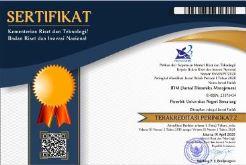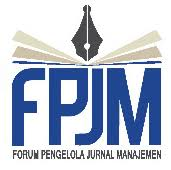Determinants of Marketing Performance: Innovation, Market Capabilities and Marketing Performance
Abstract
This research aim to analyze causality influence between innovations, market capability, social modal, entrepreneurs oriented into marketing performance. Organizational innovations is a basic focus on Total Quality Management. Innovation has a role to technological development and competitive economy environment. The sample technique used is Purpusive sampling amount 58 respondent owner of Batik Small Medium Enterprise known as UKM. Small businesses have small medium or medium can grow and develop so that it is able to increase its product and sustainability efforts on the creative industry. The technique analysis used is Parsial Least Square (PLS), this result shows entrepreneur orientation doesn’t influence into market capability and social modal, innovation has positive influence and significance into market capability and marketing performance. This results shows innovation has important role in advantaging market capability while influencing to increase marketing performance of Small Medium Enterprise known as UKM.
Penelitian ini bertujuan untuk menganalisis pengaruh kausalitas antara inovasi, kemampuan pasar, modal sosial, pengusaha berorientasi ke kinerja pemasaran. Inovasi organisasi adalah dasar TQM. Inovasi mempunyai peran pentinga dalam pengembangan teknologi dan lingkungan yang penuh persaingan. Teknik sampel yang digunakan adalah Purposive Sampling jumlah 58 pemilik responden dari Batik Kecil Menengah dikenal sebagai UKM. UKM dapat tumbuh dan berkembang melalui industri kreatif. Teknik analisis yang digunakan adalah Parsial Least Square (PLS), hasil ini menunjukkan orientasi entrepreneur tidak mempengaruhi ke kemampuan pasar dan modal sosial, inovasi berpengaruh positif dan signifikan dalam kemampuan pasar dan kinerja pemasaran. Hal ini menyebabkan menunjukkan inovasi memiliki peran penting dalam advantaging kemampuan pasar sementara yang mempengaruhi untuk meningkatkan kinerja pemasaran Kecil Menengah dikenal sebagai UKM.
Keywords
Full Text:
PDFReferences
Barney, J. B. 1991. Firm Resources and Sustained Competitive Advantage. Journal of Management. 17(1): 99 - 120.
Chen, Cheng-Nan., Tzeng, Lun-Chung & Ou, Wei-Ming. 2007. The Relationship Social Capital Entrepreneur Orientation, Organization Resource& Entrepreneurial Performance for Ventura.Contemporary Management Research. 3(3): 213-232.
Coleman, J. 1988. Social Capital in the Creation of Human Capital. American Journal of Sociology.94 (Supplement): 95-120.
Cooke, P. 2007. Social capital, Embeddedness, and Market Interactions: An Analysis of Firm Performance in UK regions. Review of Social Economy. 65 (1): 79-106
Day, G. S. 1994. Capabilities of Market-Driven Organizations. Journal of Marketing. 58 (4): 37-52.
Drucker, P. F. 1986. Management: Task, Responsibilities , Practices, Truman.New York: Talley Books, E. P. Duttion
Ferdinand, A. 2005. Modal Sosial Dan Keunggulan Bersaing: Wajah Sosial Strategi Pemasaran. Semarang: Badan Penerbit Universitas Diponegoro.
Ferdinand, A. 2014. Metode Penelitian Manajemen. Edisi Kelima. Semarang: Badan Penerbit Universitas Diponegoro.
Ghozali, I. 2013. Analisis Multi Variate.Semarang: Penerbit Universitas Diponegoro Semarang.
Grant. R.M. 1991. The Recourced- Based Theory of Competitive Advantage: Implications for Strategy Formulation.California Management Review. 33(Spring):114-135.
Griffith, D., Noble S & Chen Q. 2006. The Performance Implications of Entrepreneurial Proclivity: A Dynamic Capabilities Approach. Journal of Retailing. 82(1): 51-62.
Haroon, M & Kocak, A. 2011. The Relationship Between Entrepreneurial Orientation Dynamic Capabilities and Firm Performance: An Exploratory Study of Small Turkish Firms. International J. Business and Globalisation. 7(3): 351-366.
Hatta, I. H. 2014. Analisis Pengaruh Inovasi, Pengambilan Resiko, Otonomi dan Reaksi Proaktif terhadap Kapabilitas Pemasaran UKM Kuliner Daerah Di Jabodetabek. Jurnal manajemen Pemasaran. 8(2): 90-96.
Hine, D & Ryan, N. 1999 . Small Service Firm-Creating Valu trought Innovation. Managing Service Quality. 9 (6): 411-422.
Indriastuti. H. 2015. Membangun Kapabilitas Penginderaan Pasar, Inovasi Produk, Keunggulan Produk Modifikatif terhadap Kinerja Pemasaran. Prosiding. Presented at Managemen Dynamic Confrence, Seminar and Call Paper (MADIC), Fakultas Ekonoi Universitas Negeri Semarang, Semarang.
Mariam-Ismail. 2005. Creative Climate and Learning Organization Factors: Their Contribution Toward Innovation. Leadership & Organization Development Journal. 26 (8) 639-654.
Mavondo. F.T., Chimhanzi. J & Stewart. J. 2005. Learning Orientation and Market Orientation. European Journal of Marketing. 39(11/12): 1235-1263.
Merlo,O& Auh,S.2009. The Effects of Entrepreneurial Orientation Market Orientation, and Marketing Subunit Influence on Firm Performance. Marketing Letter. 20 (3):295-311.
Narver, J.C & Slater. 1990. The Effect of a Market Orientation on Business Profiitability.Journal of Marketing. 54 (4):20-35
Neely, A., Fillipini, R., Forza, Vinelli, A & Hii, J. 2001. A Framework For Analizing Business Performance, Firm Innovation and Related Contextul Factors: Persption of Manager and Policy Makers in Two European Regions. Integrated Manufacturing System. 12(2): 114-124.
Paulina, I & Wardoyo. 2012. Faktor Pendukung terhadap Intensi Berwirausaha pada Mahasiswa. Jurnal Dinamika Manajemen. 3 (1): 1-10.
Saeko, A. N., Chuntarung &Thoumrungroje, P. 2012. The Impact of Integrated Marketing Strategy on Mareting Performance: An Empirical Evidence From Exporting Business in Thailand. International Journal of Business Strategy. 12 (4).
Tang, J., Tang, Z., Zhang, Y & Li,Q.2007. The Impact of Entrepreneurial Orientation and Ownership Type on Firm Prformance in China. Jounal of Developmental Entrepreneurship. 12 (4): 383-397
Teece, D.J., Pisano, G & Shuen, A. 1997. Dynamic Capabilities and Strategic Management. Strategic Management Journal. 18(7): 509-533.
Villena, V. H., Revilla, E & Choi, T. Y. 2011. The Dark Side of Buyer-Supplier Relationships: A Social Capital Perspective. Journal of Operations Management. 29: 561–576.
Voss & Voss, Z. 2000. Strategic Orientation Performance and Artistic Environment.Journal of Marketing. 64: 67-83.
Weber, C & Weber, B. 2011. Exploring the Antecedents of Social Liabilities in CVC Triads: A Dynamic Social Network Perspective. Journal of Business Venturing. 26: 255–272.
Weerawerdana, J. 2003. Exploring The Role of Market Larning Capability in Competitive Strategy. European Journal of Marketing. 37: 407-429.
Wernefelt, B.1984 . A Resource-based View of the Firm. Strategic Management Journal. 5: 171-180.
Wincent, J., Thorgren, S & Anokhin, S. 2013. Managing Maturing Government-Supported Networks: The Shift from Monitoring to Embeddedness Controls. British Journal of Management. 24: 480–497.
Wincent, J., Thorgren, S & Anokhin, S. 2014. Entrepreneurial Orientation and Network Board Diversity in Network Organizations. Journal of Business Venturing. 29: 327–344.
Yulianto, A. 2010. Meningkatkah Kualitas Pelayanan Jasa Penerbangan Indonesia Paska Insiden Kecelakaan Pesawat Terbang? Jurnal Dinamika Manajemen. 1(1): 1-8.
View Counter: Abstract - 5629 and PDF - 3827
Refbacks
- There are currently no refbacks.





